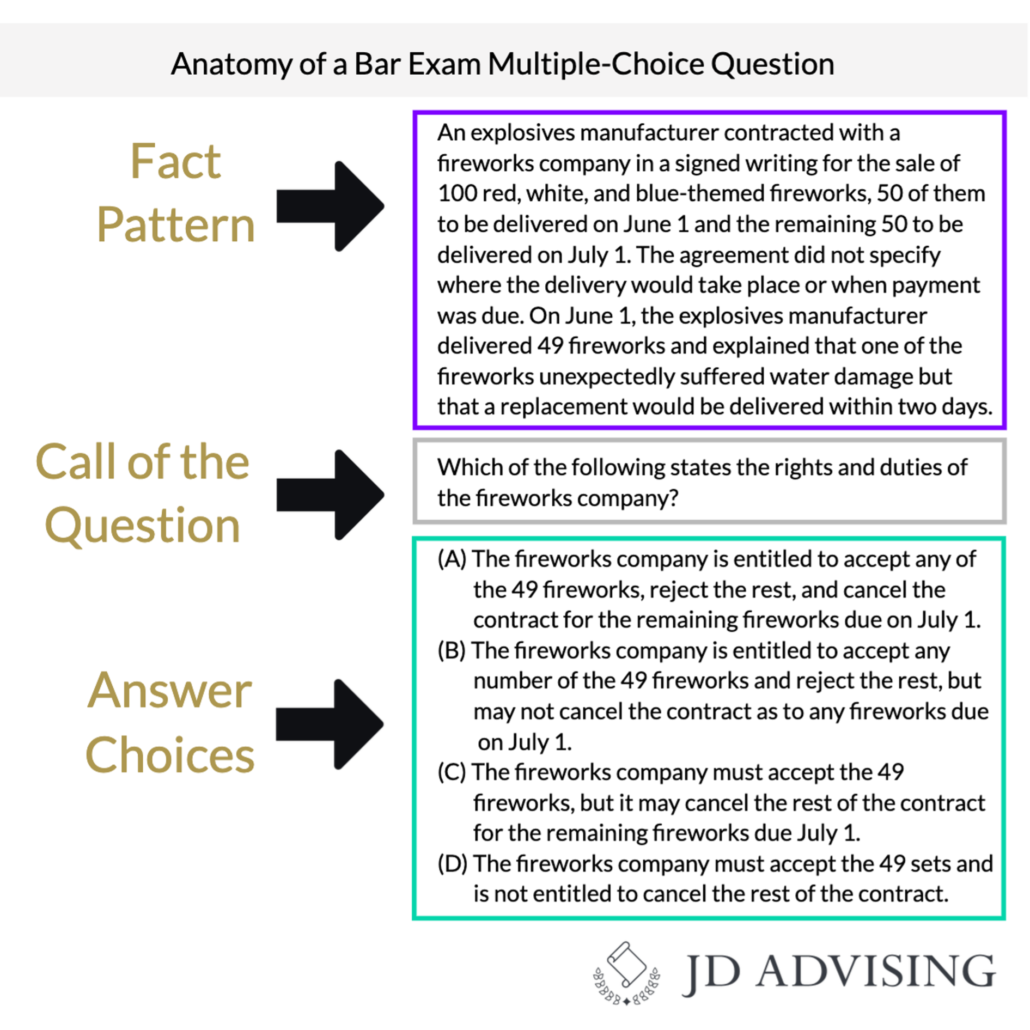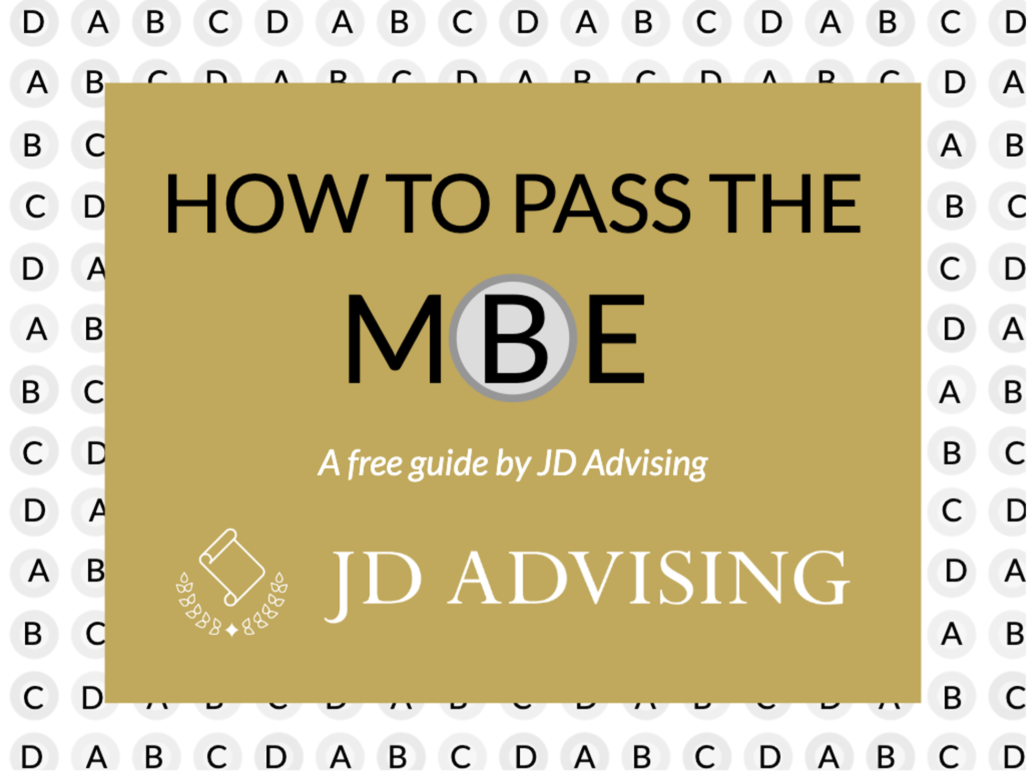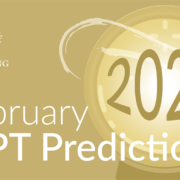Topic 6: How to Read and Answer an MBE Question
Topic 6: How to Read and Answer an MBE Question
Many students ask, “What is the best way to answer multiple-choice questions? Should I read the call of the question first? Should I read the answer choices first?” Here, we show you the approach for multiple-choice questions that will help you maximize your MBE score. This approach is what helped our JD Advising founder score a 180 on the MBE and has helped countless JD Advising students boost their MBE scores significantly.
This approach will help you “dissect” MBE questions when you practice. It takes some time to answer an MBE question using this method, but you will see your score improve if you answer questions slowly and methodically to start with. If you have been frustrated and “stuck” at the same MBE score, it is worth it to step back and try this method.
The “skill” of answering MBE questions
Correctly answering MBE questions is a skill. Many examinees rush through MBE questions to try to get through as many as possible in hopes that they will see their score improve. However, if you want to see your MBE score improve, it makes much more sense to slow down, dissect questions, understand exactly how the questions are written, and then start to speed up.
If you wanted to get better at painting, one way to approach it would just be to paint 100 canvases in a row as fast as you could. This is similar to the approach many examinees take to MBE questions! This approach often leads to frustration and anxiety. And, while you may see your painting skills (or MBE score) improve a little, you will not see any great improvement. A much better way to approach painting would be to start slowly; learn the skills you need to paint; practice painting details, contrast, etc.; then start speeding up. You will see much faster progress in your painting (and your MBE skills) if you take the latter approach. Here, we tell you how to dissect an MBE question using a slower, more methodical approach.
If you prefer to watch a video of this process, check it out below!
Step one: read the fact pattern, then read the call of the question, then STOP.
How to read an MBE question
The first step toward answering an MBE question correctly is to read it correctly! The “correct” way to read an MBE question is a way that allows you to focus on the facts so you can identify the legal issue and pick the correct answer choice.
There are two approaches to MBE questions. Try both and see what works for you. Because most students find the first approach most effective, that is the approach we typically recommend. However, before we discuss the approaches, here is the anatomy of an MBE multiple-choice question.

“Fact pattern first” approach
This approach works well for many of our students. Some students (who have been using the “call of the question first” approach) find this makes a big difference in their ability to focus on the fact pattern.
The “fact pattern first” approach is simple. You simply start at the beginning of the question and read it through. The advantage of this approach is you can concentrate on the facts. This helps increase focus and reduces the number of times you have to reread the fact pattern. It also reduces the number of times you feel stuck between two answer choices. Why? With a clear view of the facts, the right answer is more easily apparent to you!
This approach works well for the vast majority of students. However, it is worth it to try the next approach if you do not find this one helpful.
“Call of the question first” approach
With this approach, you start right with the call of the question. The advantage of this approach is that you can sometimes pick out the subject being tested (e.g., Contracts rather than Torts) and you can also get an idea of the topic in some cases (e.g., homicide, negligence, etc.) before you even read the fact pattern. Having an idea of the topic tested can help you focus on the more pertinent facts while not getting lost in the details that do not matter. That is why some students find the ”call of the question first” approach more helpful than the “fact pattern first” approach. The downside is that sometimes students find themselves rereading the fact pattern or losing focus because they get too fixated on what they “should be” looking for. So, in general we recommend the “fact pattern first” approach.
Do not read the answer choices first!
If you find yourself glancing at the answer choices, try covering them up as you go through practice questions. Many wrong answer choices are written to intentionally trick you. For example, if you read an answer choice that sounds good, you are susceptible to misreading the fact pattern in a way that points you toward your predetermined answer choice. Also, some answer choices might correctly state the law, but they are not relevant to the given facts. You will not know whether the answer choices are relevant until after you read the facts!
Step two: identify the subject.
Which subject is being tested (Civil Procedure, Constitutional Law, Contracts & Sales, Criminal Law & Procedure, Evidence, Real Property, or Torts)? Figuring out the subject that is being tested is the second step.
Step three: identify the legal issue being tested.
For example, if it is a Real Property question, is this an adverse possession issue? A future covenants issue? An easement by prescription issue? Being able to identify the legal issue is crucial to being able to answer the question correctly.
Step four: state the rule.
State the legal rule applicable to the issue you identify in step three. When you are practicing, it may be helpful to write this rule down to see how well you can recite it. If you cannot remember the actual rule, look it up in your outline and then write it down so that you are more likely to remember it the next time you encounter a similar question!
Note: If you struggle with identifying the applicable issue and legal rule, you may need to spend more time memorizing your outlines and the rules before completing more practice questions. For tips on how to memorize your outlines, see this post.
Step five: answer the question without looking at the answer choices.
Without looking at the answer choices, answer the call of the question based on the rule that you just stated. Answering the question before reading the answer choices will prevent you from picking a deceptive answer that is intended to trick you. If you find that you need to look at the answer choices to discern the applicable law being tested by a question, you may need to spend more time memorizing your outlines and the laws.
Note: Some MBE questions are written in such a way that you must look at the answer choices to answer the question. In general, however, we do not recommend you do this if you can avoid it.
Step six: find the correct answer choice.
Read the answer choices and select the answer choice that comes to the correct conclusion based on the law(s) you just identified.
Step seven: review the incorrect answer choices.
Read the other answer choices and explain why each one is incorrect. This will help you to feel more confident in your answer choice. And it will test whether you really know the law.
This approach should take a long time for each question (5 to 10 minutes). But that is okay. When you are completing practice questions, your goal should be to learn the law, not to simply answer as many questions as possible. Using this approach, you might only answer 10 practice multiple-choice questions each day and that is OK! When it is time to take the actual test, the degree to which you know the law is more important than the number of practice questions you did! We have some students that complete 300 questions during their bar prep and pass the MBE with flying colors. Then, we hear of others that complete 5,000 MBE questions and fail. Quality is more important than quantity.
An Important Final Step
If you get a question wrong, do not just read the answer explanation. That is not enough!
We recommend that if you do not know the law or if you answer an MBE question incorrectly that you write down the law you did not know or the reason that you answered the question incorrectly on a separate notepad. Then, keep reviewing this notepad. You will constantly be exposed to the law that you previously did not know. And you may begin to see patterns in areas of law you need to work on memorizing. This is a fantastic way to see improvement in your MBE score and is discussed in more detail in topic 4.
Some students simply read the answer explanation and hope that they remember it for the future. The problem with just reading the answer explanation is that you are learning so much law, you will surely forget what you learned if you do not review it! Consistently reviewing the law that you do not know is a great way to commit it to memory.
The Advantages of “Dissecting” MBE Questions
There are several advantages to using a slow and methodical plan to dissect MBE questions. Here, we list some of the advantages:
- First, it will help you learn the rules. By challenging yourself to state the rule every time you see an MBE question, you will learn the rules that much better.
- Second, it will keep you engaged. This is a very active and organized way of approaching the MBE. You are less likely to suffer fatigue or lose your concentration.
- Third, you will start to understand how MBE questions work. You could read theory about MBE questions all day, but if you answer them slowly and methodically, you will begin to intuitively understand how they are written and how to approach them.
- You will find yourself getting tricked less often. By using a step-by-step approach to MBE questions, you will avoid the common traps and red herrings that trick most students.
- It will decrease stress and anxiety. Students that race through several MBE questions a day often never see any true score improvement. This leads to a vicious cycle of answering questions, feeling stressed out, then answering more questions and feeling even more stressed out when they get the same score. This is not productive! By slowing down, you will see a score improvement and thus decrease your stress.
- It will help you improve your timing. It seems counterintuitive, but by going through questions slowly and methodically, your timing actually will improve! We have seen countless students improve their timing on the MBE using this method. They find themselves quickly and confidently dissecting MBE questions rather than feeling lost.
- Lastly, it is the best way to efficiently approach the MBE. You are not just going through the motions. Rather, you are taking an organized and methodical approach. This is truly the best way to spend your time!
A note on timed exams
During the real MBE, you will not be going through questions this slowly. This approach is to help you improve your score when you practice. So, it is important to incorporate timed exams into your study schedule as well. Do not ignore timing! We recommend you incorporate both the slow and methodical method of dissecting MBE questions as well as taking timed exams into your MBE practice. However, when you are just starting out, use the dissecting method before you practice answering questions under timed conditions.
Go to the next topic, Topic 7: Try It out!
Seeking MBE Assistance?
Seeking MBE Assistance?
- 📘 MBE Guide: Equip yourself with our FREE expert-crafted bar exam and MBE guides.
- Free Bar Exam Resource Center: Discover top resources, articles, and free webinars led by renowned bar exam professionals.
Top Resources as Vouched by our Students:
- MBE One-Sheets: One of our most highly acclaimed bar exam supplements!
- Bar Exam Outlines: Our comprehensive and condensed bar exam outlines present key information in an organized, easy-to-digest layout.
- MBE Private Tutoring: Opt for personalized, effective strategies.
- On Demand Bar Exam Course: Comprehensive bar exam preparation.
- Bar Exam Crash Course and Mini Outlines: Acclaimed and effective for a quick refresher.
- MBE Mastery Class, Real MBE Questions, and MBE Guide: Elevate your MBE preparation with these high-quality MBE supplements!
🔥 NEW! Check out our Repeat Taker Bar Exam Course and get introduced to our unmatched platinum Guarantee Pass Program.






Leave a Reply
Want to join the discussion?Feel free to contribute!